Ultimate Portable HF Vertical Antenna
Introduction
Due to the tremendous response to my portable vertical antenna (July 2002 QST), I've continued to evolve the design. Now, I've come up with a longer, lighter and more compact (when disassembled) antenna that is easier to build, and easier to find parts for. And band coverage is now 60 through 10 meters.
As before, this new antenna breaks down into multiple mast sections, a whip, an air-wound center loading coil, and a base support. No piece is longer than about 20-inches so it will fit into most suitcases, yet the fully assembled antenna has a length of almost 16-feet! Photo "Author & Package" shows the disassembled antenna with guys and radials. See photos "Author & Vertical", and "Front Yard" for pictures of the fully assembled vertical. As most of you know, the key to antenna efficiency is length. The longer the antenna, the greater the radiation resistance and therefore the less impact on efficiency from ground and coil losses. This antenna is a full quarter-wavelength on 20-10 meters, and minimizes the coil necessary for 60-, 40- and 30-meters.
Gathering the parts
- One 5" long x 2.5" diameter x 10 TPI air wound coil (MFJ-404-008 @ $14.95 each)
- One 10-foot telescoping whip (MFJ-1954 @ $19.95 each)
- One SO-239 chassis mount connector (MFJ-610-2005 $ $2.95 each)
- Five coil clips (MFJ-605-4001 @ $2.95 each) -- Optional, see text.
- One 3/8" diameter wood dowel (Home Depot -- only 5-1/2" needed)
- Two 3-foot pieces of 1/2" OD - 3/8:ID AL tubing (Home Depot, ACE)
Or 6-foot ½ inch OD-3/8:ID AL tubing (McMaster 89965K54 or Texas Towers)
- One 3/4" PVC-T (Home Depot, ACE, McMaster 4880K42)
- Two 3/4"-to-1/2" PVC adapter (Home Depot, ACE, McMaster 4880K201)
- One 3/4" PVC slip plug (Home Depot or ACE Hardware)
- One 1/2x1/8 NPT brass adapter (ACE, McMaster 50785K64)
- Five 1/8 NPT brass couplings (Home Depot, ACE, McMaster 50785K91)
- Four 1/8 NPT CLOSE nipples (Home Depot, ACE, McMaster 50785K151)
- Three 1/8 NPT hex nipples (Home Depot, ACE, McMaster 5485K21)
- Two #8 brass wing-nuts (ACE)
- Two #8 x 3/4" brass screws (Home Depot or ACE)
- Two #8 brass nuts (Home Depot or ACE)
- Two #8 copper-plated steel split lock washers (ACE)
- One 36" long-1/8" dia. brass rod (ACE, Home Depot, McMaster 8953K41 $1.77/6')
- One 3/8x16 x 1-1/4" hex head carriage bolt, zinc plated (Home Depot, ACE Hardware)
- One 3/8x16 x 12" hex head carriage bolt, zinc plated (Home Depot)
- One 3/8x16 coupler, zinc plated (Home Depot or ACE Hardware)
- Two 3/8x16 nuts, zinc plated Home Depot or ACE Hardware)
- One 3/8 lockwasher, zinc plated (Home Depot or ACE Hardware)
- Four #6 stainless steel 3/8" sheet metal screws (ACE Hardware)
- Two #4 stainless steel 3/8" sheet metal screws (ACE Hardware)
- Three #8 spade lugs (Home Depot)
- 90 ft wire (Any gauge, insulated or not, for six 15-foot ground radials)
- Six #8 x 1-1/2" brass wood screws (Home Depot or ACE Hardware)
Note: Recommended Tool - Harbor Freight 39391-5VGA Tap & Die Kit @ $12.99 is inexpensive and provides all the thread sizes you'll probably ever need.
You can order the parts as the
MFJ-1964K kit through the MFJ website.
Referring to Figure 1, cut the 1/2" OD tubes to 18" lengths with a hacksaw or tubing cutter and de-burr the tubing. Thread the inside of both ends of three of the 18" long aluminum tubes with a 1/8NPT tap. See photo "Tapping". Once you've tapped these tubes, screw a 1/8NPT hex nipple into one end of each tube finger tight. Slide two 1" pieces of ½" heat shrink tubing over the rods. Then, on the opposite end of each tube, screw a 1/8NPT CLOSE nipple and a 1/8NPT coupling, again finger tight. See photos "Female & Male parts". Now grasp each hex end with pliers and tighten everything as tight as you can. Don’t strip out the threads, however! Refer to "Male & Female with & without heat-shrink" to see photos of the completed tube ends with and without the heat-shrink in place.
Loading Coil Assembly
Screw a 1/8-NPT coupling on each end of a 0.7" 1/8-NPT CLOSE nipple as tight as possible, using pliers or wrenches. Now unscrew the couplings. One end of the nipple will brake loose from one coupling, and the other end will stay tight in the remaining coupling. You’ll now have a female and male end that will fit over each end of the 3/8" diameter wooden dowel used for the coil support. See "Nipple & couplings". Referring to Figure 2, thread a 3-1/2" long piece of the 3/8" diameter wood dowel using the 1/8NPT die. Now you can screw the male and female brass pairs directly onto the wood dowel (screw the couplings snugly on, but do not strip the wood threads). Drill a 1/8" diameter hole completely through each of the 1/8-NPT brass couplings and dowel as shown. Next cut two 3" lengths of the 1/8" diameter brass rod. Insert one of these 3" sections through the holes on one brass coupling. Center the rod so that equal lengths are available on both sides of the coupling, and solder the rod to the coupling with a large soldering iron or torch (be careful not to burn the wood dowel with the torch!).
Now cut a 3" length of the MFJ-404-008 coil and position this coil such that the 1/8" diameter 3" brass rod just installed pokes through the last two turns on the coil (Note: You can use the full 5" length of coil if you wish, which will give you more options for shortening the antenna on given bands. Change the wood dowel length to 5-1/2" if you elect to do this.). See "Coil before soldering". Solder the coil turns to the rod. On the opposite end of the coil assembly, insert the remaining 3" brass rod through two adjacent turns on this end of the coil, through the brass coupling, and through the coil turns. Solder the coil turns to the brass rod, and then solder the brass rod to the coupling. See "Coil after soldering". If you wish, you can use a 1-1/2" piece of 1/8" brass rod and support each side of the coil at a single point. This will make assembly easier, but the coil support won't be as robust.
Now indent every other turn on the coil with a small flat-head screwdriver. You will need to do this on opposite sides of the coil to give you plenty of adjustment capability. Finally, on the end of the coil with the brass nipple (male end), solder a 6" piece of insulated wire terminated with an alligator clip. For extended outdoor use, you may wish to treat the wood dowel with varnish.
Base Assembly
Note: Check the alternative matching bases in another article on this web page.
I used a 3/8x16 x 12” zinc plated hex head carriage bolt for the base spike. Only 1-1/2" of the carriage bolt is threaded, so I used the long smooth end of the bolt to go into the ground after cutting off the hex head. I also used a 3/8x16 x 1-1/4" zinc plated hex head carriage bolt at the base of the PVC assembly, and a 3/8x16 zinc plated coupler to attach the 1-1/4" bolt to the 12" bolt as shown in Figure 3. This way you can leave the long bolt off if you want to bolt the base assembly directly to a metal plate or trailer mount. Or you can screw on the long bolt for ground mounting.
Referring to Figure 3, drill a 3/8" diameter hole into the 3/4" PVC plug used for the base support 1-1/4" carriage bolt. Cut off about half of the length of the 3/4" PVC plug to leave plenty of room inside the "T" for wiring. Solder a ground wire to the head of the 3/8x16 x 1-1/4" carriage bolt as shown, insert the carriage bolt threaded end into the plug, and secure with a 3/8x16 nut and a lockwasher as shown.
To prepare the 12" carriage bolt, cut off the hex head and round this end with a file. Screw the 3/8x16 coupler over the threaded end, and screw the 3/8x16 nut against the coupler (lockwasher should be between the nut and coupler). This 12” carriage bolt assembly can now be easily screwed on to the 1-1/4” bolt on the base assembly for ground mounting.
Now place the SO-239 temporarily over one of the 1/2"x3/4" PVC adapters and mark the location for two #4 x 3/8" stainless steel machine screws that will hold it in place. Carefully drill two 1/16" holes at these points. Place the 3/4" PVC plug/spike assembly in the "T" and drill two 1/16" diameter holes through the "T" and plug. Remove this assembly from the "T" and drill out these 1/16" holes in the "T" to 1/8". Also drill out two holes in the SO-239 connector to 1/8" since the holes to give plenty of space to pass the #4 x 3/8" sheet metal screws.
Next we'll prepare the antenna interface at the top of the base. First, cut off part of the 3/4 x 1/2" PVC adapter so as to leave additional room in the "T" for wiring. Solder a piece of #14 copper house wire directly to the inside lip of the 1/2 x 1/8NPT brass adapter. You'll need a large soldering iron or a Solder-It torch since the brass adapter mass is pretty large. Screw this adapter tightly into the 3/4 x 1/2" PVC adapter.
Now solder a wire to the center conductor of the SO-239 connector as shown. This wire should be soldered to the wire stub on the 1/2 x 1/8NPT brass adapter at the antenna interface, and then to the upper wing-nut assembly. Solder a short piece of copper braid (from a piece of RG-58 cable) from the SO-239 ground (solder directly to the SO-239 body) to the brass ground screw, and finally to the wire soldered to the head of the 1-1/4" carriage bolt. You can now complete the assembly of the base by inserting the PVC plug/1-1/4" carriage bolt assembly into the "T" and installing the stainless steel sheet metal screws as shown in Figure 3. Alternately, you can PVC-glue everything in place, but you'll never be able to get the assembly apart again if you do this. Incidentally, the upper wing-nut assembly shown is used to add capacitive or inductive base matching should you want to improve your VSWR on the lower bands. See photos "Base with Spike" and "Base and Spike".
Ground Radial Network
The radial network consists of six 15-foot radials using any gauge wire, insulated or not (I use #22 insulated wire). I've found it best to make up three pairs of two wires each attached to a #8 spade lug on one end of each pair. This minimizes the hassle of deploying, and later rolling up, the radials. The three #8 lugs attach to the ground screw on the base assembly. When the wires are rolled up, hold them together with twist-wraps. On the outer end of each radial, solder on a 1-1/2" brass wood screw. These screws are pushed into the ground to hold the radials in place. Put a blob of hot glue on each wire/screw soldered interface to give it a little strain relief.
Guying
While this antenna is self-supporting in a low-breeze environment, in many cases it will be necessary to guy the antenna due to its 16-foot length. For effective guying, I attached nine-foot lengths of nylon cord (3 pieces) just above the base of the 10-foot MFJ telescoping whip. This is easily done by taking a tie-wrap and closing it just enough so that it won't slide over the base of the MFJ whip. Cut the 9-foot sections of nylon cord and heat the ends with a match to fuse the nylon so it won’t unravel. Tie one end of a 9-foot section of nylon cord around each tie-wrap and secure with hot glue or epoxy. For the ground stakes, you can use the extra piece of aluminum tubing (you only used 4-1/2 feet of the 6-feet purchased). Cut the remaining 18" piece of tubing into three six-inch tubing sections. Attach the non-tie wrap end of the nylon cord to one end of each tube with hot glue. Also plug the open ends of the three tubes with hot glue. For storage, wrap the nylon cord around each brass stake and hold in place with masking tape. See photos "Guy Closeup", and "Nylon wrapped". See "Coil & Guy" for a photo of the guys attached to the telescoping MFJ whip. When bolted to a trailer mount or plate, the antenna should really not need guying unless the wind is very strong.
Antenna Assembly
To assemble the antenna, first screw the three 20-inch rods together, and then screw these into the top of the base assembly. Push this base/rod assembly firmly into the ground, keeping it as vertical as possible. Next screw the loading coil and telescoping whip assemblies together. Slip the three guy tie-wrap/nylon cord assemblies over the whip and extend the telescoping whip. Screw this entire top assembly into the female end of the aluminum tube assembly currently pushed into the ground. Finger tight is all that is necessary for all brass fitting interconnections. Finally, push the guy rods in the ground and extend the six radials. Attach the common ends to the ground screw on the base assembly.
Antenna Set-up
To begin, use an antenna analyzer set to 5340 KHz to locate the coil tap point that gives the best VSWR. Mark this tap point. Repeat at 5380 KHz. Move to 40 meters and repeat, again selecting two taps on 40 meters so as to give you enough band coverage. Repeat again for 30 meters -- only a single tap is required for this band. For 20-meters, you will find that only the top turn of the coil is necessary for resonance. The antenna is almost a quarter-wave long on 20 meters.
For 17, 15, 12 and 10 meters, you will need to short out the entire loading coil and then adjust the whip for resonance. On these bands, the antenna will be a quarter-wave long. Alternately, you can remove two tubing sections for 17 and 15 meters, and all three sections for 12 and 10 meters, but you’ll still need to adjust the telescoping whip length. Use a permanent black marker pen to indicate the correct band positions on the telescoping whip.
You can either clip the alligator clip-lead directly to the coil turns, or use the MFJ-605-4001 coil clips. From this point forward, just go back to these tap points, or re-adjust the top whip as necessary. The VSWR should be fine.
If your rig cannot tolerate a 2:1 VSWR, you will need to add a 330 pf 300V silver mica capacitor across the two wing-nut assemblies for 60 meters, and a 220 pf capacitor for 40- and 30-meters. See "Base & capacitor". No capacitors are needed for 20-10 meters. I find that neither my IC-706MKIIG nor my IC-703 is bothered by a 2:1 VSWR.
Mounting Options
You can easily make a 3/8x24 interface so that the antenna can be mounted on a standard 3/8 x 24 ham mount. This would be useful for those with a standard ball mount on their car who want to use this extended length antenna when stopped. As discussed earlier, the 1/8-NPT thread is just a slightly tapered 3/8x24 thread. And, while the 3/8x24 standard stud will screw into a 1/8NPT thread, the 1/8NPT nipple will not screw into a 3/8x24 threaded hole. Therefore, an adapter is necessary.
Referring to Figure 4, screw a 3/8x24 bolt (your local hardware store again) tightly into a 1/8-NPT coupling. Cut off the head of the 3/8x24 bolt with a hack saw and file carefully so that the threads are OK for screwing into a 3/8x24 socket. You can now screw this assembly onto the 1/8-NPT nipple on the bottom aluminum rod section.
Conclusion
This antenna is longer, lighter, more compact, easier to fabricate, and gives you more mounting options than the original unit published in QST. Experiment with the antenna length -- i.e. remove a section or two, use more or fewer sections, decrease or increase sections lengths, or place the loading coil in different positions. For best efficiency, try to keep the antenna as long as possible and the coil as high as possible.
And don't hesitate to make changes based on hardware availability. Try brass or copper tubing, or even wire wrapped 3/8" fiberglass or wood dowel. Use different PVC assemblies. Its fun to design antennas "on the fly" while standing in the plumbing section of your hardware store, which can lead to interesting discussions with the clerks!



Figure 3 -- Base Assembly

Figure 4 -- Adapt to Standard 3/8x24 Base

Author & Disassembled Antenna

Author & Vertical

Front Yard

Tapping The ½" Aluminum Tube

Parts For Female End

Parts For Male End

Female End: With & Without Heat-Shrink

Male End: With & Without Heat-Shrink

Nipple & Couplings

Coil Before Soldering

Coil After Soldering

Base With Spike
Read more...

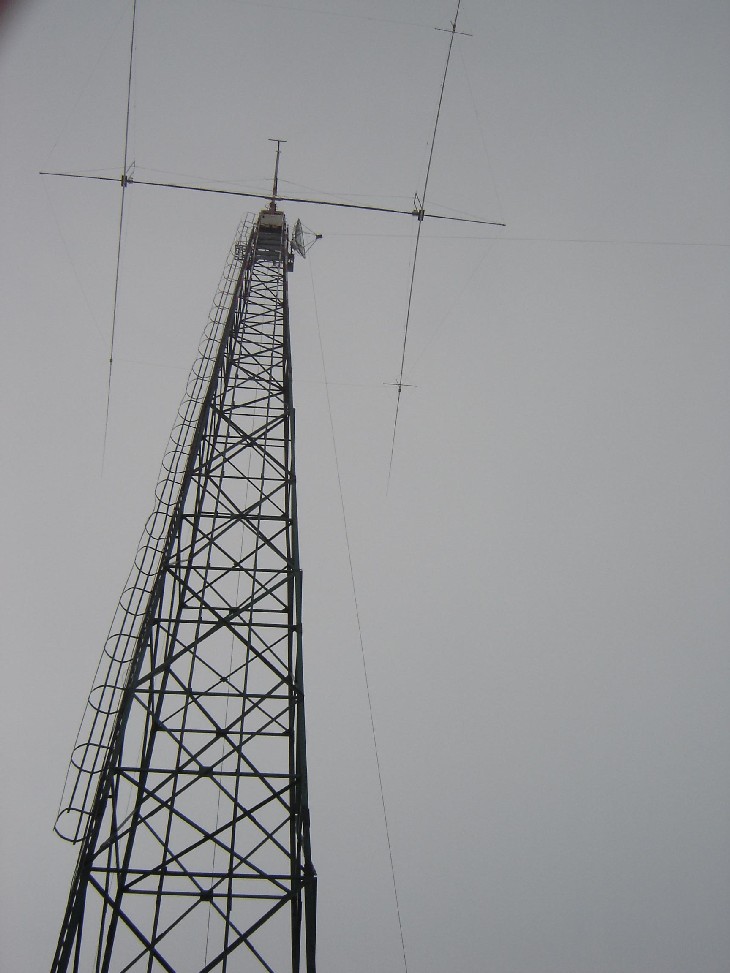







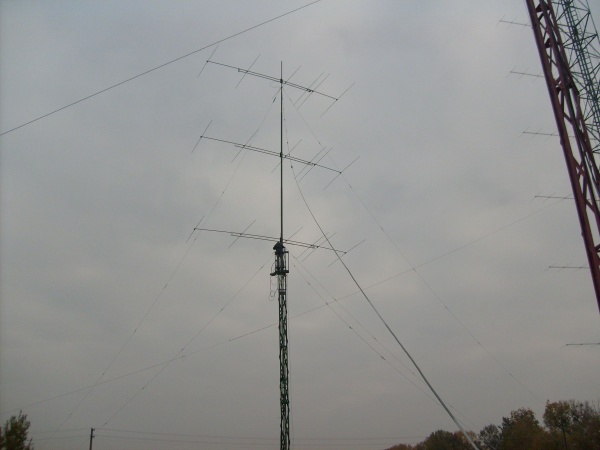


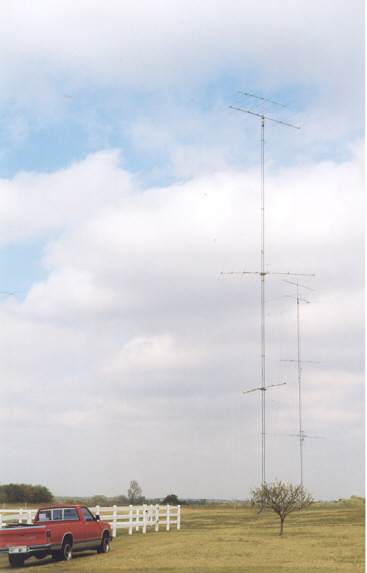
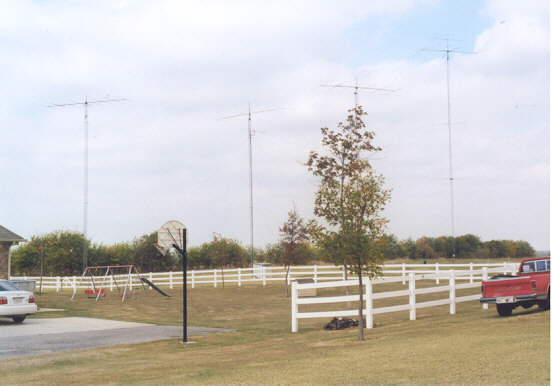

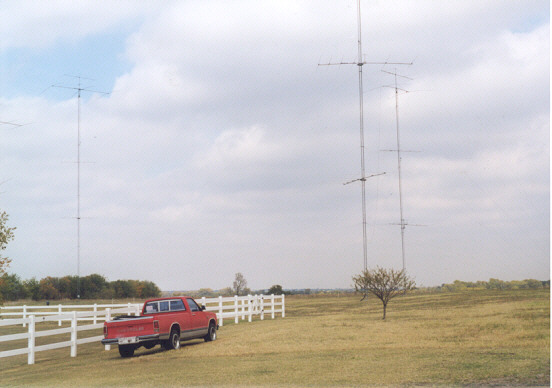


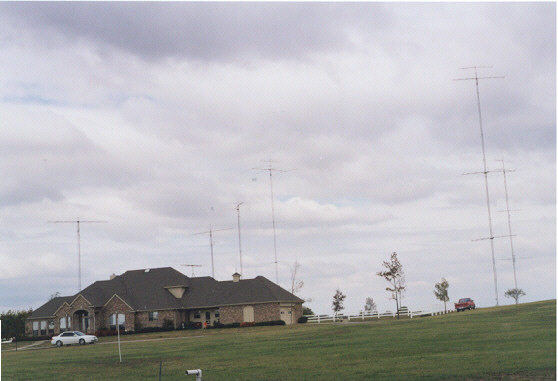
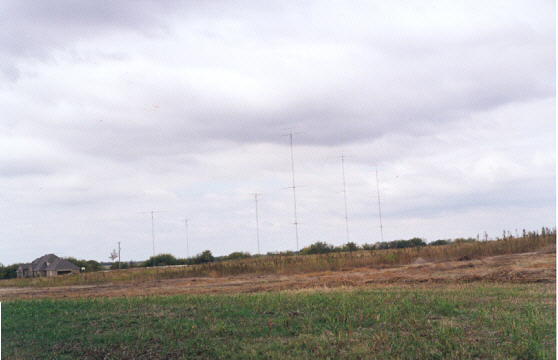




















 Figure 1
Figure 1 (Looking Down From Above)
(Looking Down From Above) Figure 1
Figure 1 (Looking Down From Above)
(Looking Down From Above)
